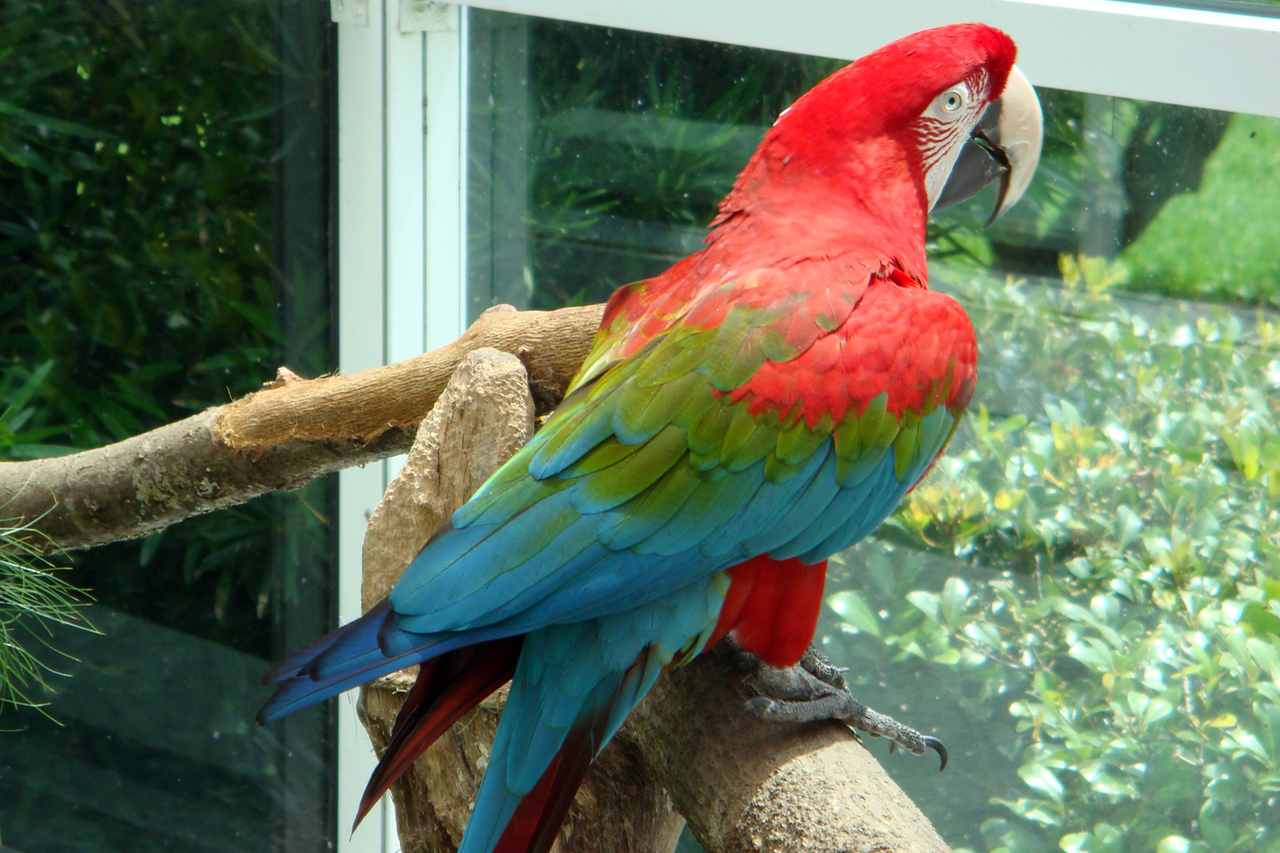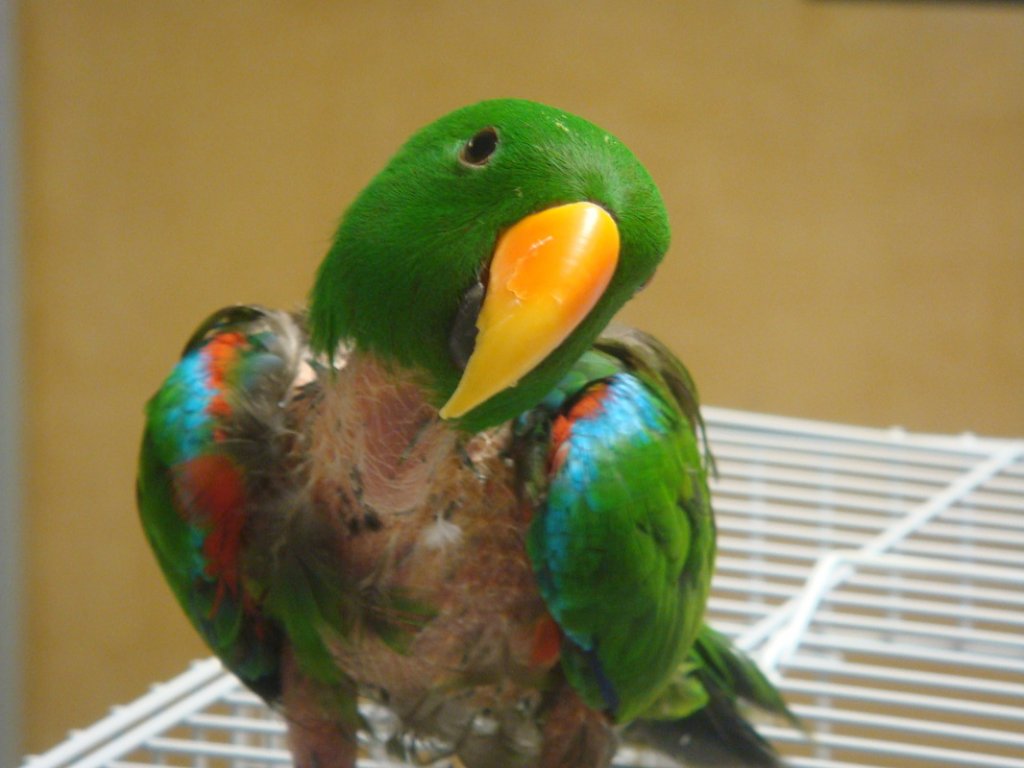by Lisa Radosta DVM, DACVB & Alison Okell BS
Of course, you can and there are many reasons why you should! Geriatric birds can suffer from many of the same ailments that other pets face when growing older; including arthritis, cataracts, muscle wasting and weight changes. As a result, as your bird ages she should receive a physical exam and labwork on a regular basis. Training is a great way to help your bird prepare for her veterinary visits making them stress free for everyone. Two great indicators of a healthy bird are feather condition and weight. With a little training, you can monitor both of these areas at home.
Clicker training is a great way to teach your bird new behaviors. Before you can use the clicker to train or capture behaviors you must teach your bird what the clicker means. You will need a few tools to get started: a clicker and your bird’s favorite treats. Pair the clicker with treats by clicking and handing your bird a treat immediately. Do this until your bird looks at you when you click. When he does you know that he has made an association between treats and the clicker. Now you can begin to use your clicker to help you capture or mark behaviors that will help you monitor your bird’s health and give him the best care possible as he ages.
Things to look for
- Sturdy perch
- Similar to your bird’s home perch
- Range: 0-5000g
Teaching your bird to weigh herself
Weight changes can indicate infection or disease. By simply monitoring your bird’s weight you canher to have a better quality of life in her twilight years. Monitoring your birds weight is as easy as teaching her to step up onto a perch. There are many types of inexpensive digital scales that can be purchased online. Choose one with a range up to 1500g.
Once you have found your scale, a sturdy perch that can be placed on the scale must be constructed. If you are not handy, scales with perches attached can be readily purchased. Keep in mind your bird will feel most comfortable stepping on the scale perch that is similar to the perches she uses now. The perch must be strong enough to support your bird and make her feel secure. Once you have your scale and perch ready you can then begin training your bird. If you bird knows how to step up onto a perch, simply ask her to do so onto the scale perch. Remember to reward her when she does. Be patient, some birds are afraid of novelty. Give her some time. Once she will step onto the scale perch, begin to lengthen the amount of time that she has to stand on it to get the treat.
If your bird is not comfortable stepping up onto new things, you may have to shape this behavior using treats and a clicker. Start by luring your bird towards the perch by putting a treat near it. This may take several training sessions. Click and treat your bird for moving close to the perch. Over multiple training sessions, click and treat her for touching the perch with her foot, then stepping onto the perch and then staying on the perch for longer and longer periods of time. In the wild your bird would stand on tree perches all day long, so if you make your perch secure your bird will feel comfortable on it just as if she were perching in a tree or a cage. Once you have taught your bird to perch on a scale you should weigh her monthly. A weight fluctuation up or down 2.5-5% may be an indicator that something might be off with your bird’s health and you should consult your veterinarian.
Inspecting your bird’s feathers
Good feather quality is another great indicator of a healthy bird. You can teach your bird to open its wings by capturing the behavior using a clicker and treats. Captive birds will at times spread their wings to stretch or to preen. This is the best time to capture this behavior. Simply click and treat time you see your bird spreading her wings. The more your reward the behavior, the more frequently your bird will offer the behavior. Essentially your bird will start to realize that every time she opens her wings she gets a treat. Then begin to add a cue to tell your bird to open her wings when you ask her to. When your bird opens her wings add your cue “wings” and click and treat for the behavior. Now you are essentially pairing your cue with the behavior. Once you have practiced this numerous times, test your bird by asking her to open her wings by saying “wings.” If she spreads her wings, click and treat. This behavior also gives you the opportunity to see your bird’s wings and feather condition in a way that is not stressful to you or your bird. If you begin to see that your bird’s feather quality is declining or she is not preening her feathers like she used to, consult your veterinarian.
As your bird ages, you will inevitably be taking her to the veterinarian’s office more frequently. These visits can be stressful to your bird if she is not used to traveling in a crate. You should begin counter conditioning your bird to the crate well before she needs to go to the veterinarian’s office. You can do this simply by pairing good things with your bird’s travel crate. Your bird may be frightened by the sight of the crate in the beginning. If this is the case, leave it near his cage in an area where she can see the crate without being frightened of it. Once your bird is no longer showing signs of fear when she sees the crate you can begin to feed her near or on the crate. When your bird will readily eat from the edge of the crate door, you can begin tossing treats into the crate. When your bird is going into the crate you can begin closing the crate door for a second at first. Then, over many training sessions, you close the door for longer and longer periods of time. Don’t forget to keep rewarding your bird for not being scared of the crate. Teaching your bird to like her crate could take a week or months (longer if she only associates the crate with stressful events) so begin crate training early. All of these behaviors can help your bird to grow old gracefully and live a long healthy life with you.


